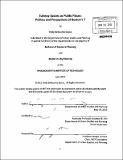Subway spaces as public places : politics and perceptions of Boston's T
Author(s)
Durso, Holly Bellocchio
DownloadFull printable version (13.72Mb)
Other Contributors
Massachusetts Institute of Technology. Dept. of Urban Studies and Planning.
Advisor
Annette M. Kim.
Terms of use
Metadata
Show full item recordAbstract
Subways play crucial transportation roles in our cities, but they also act as unique public spaces, distinguished by specific design characteristics, governed by powerful state-run institutions, and subject to intense public scrutiny and social debate. This thesis takes the case of the United States' oldest subway system-Boston's T-and explores how and why its spaces and regulations over their appropriate use have changed over time in response to public perceptions, political battles, and broader social forces. I use data collected from historical newspaper archives, published reports, and official agency records to detail how the city's subway authorities-first the Boston Elevated Railway Company, then the Metropolitan Transit Authority (MTA), and presently the Massachusetts Bay Transportation Authority (MBTA)-have sought to manage and shape these unique underground spaces and simultaneously maintain an image of order and control within them. My research reveals and more closely examines three major factors that have influenced the changing controls over subway space usage in Boston: (1) the highly specific design constraints and unique physical aspects of the city's subway spaces; (2) evolving values and ideologies embedded within the transit agencies that are continuously seeking to promote a positive image of themselves; and (3) persisting public perceptions of subway spaces, many of which revolve around historical fears of the unknown and unfamiliar. By highlighting these complex hidden processes at work within Boston's underground realm, this thesis promotes a careful reexamination of a heavily used yet underappreciated urban space for the purposes of better understanding our experiences with and connections to the city.
Description
Thesis (M.C.P.)--Massachusetts Institute of Technology, Dept. of Urban Studies and Planning, 2011. Cataloged from PDF version of thesis. Includes bibliographical references (p. 145-160).
Date issued
2011Department
Massachusetts Institute of Technology. Department of Urban Studies and PlanningPublisher
Massachusetts Institute of Technology
Keywords
Urban Studies and Planning.